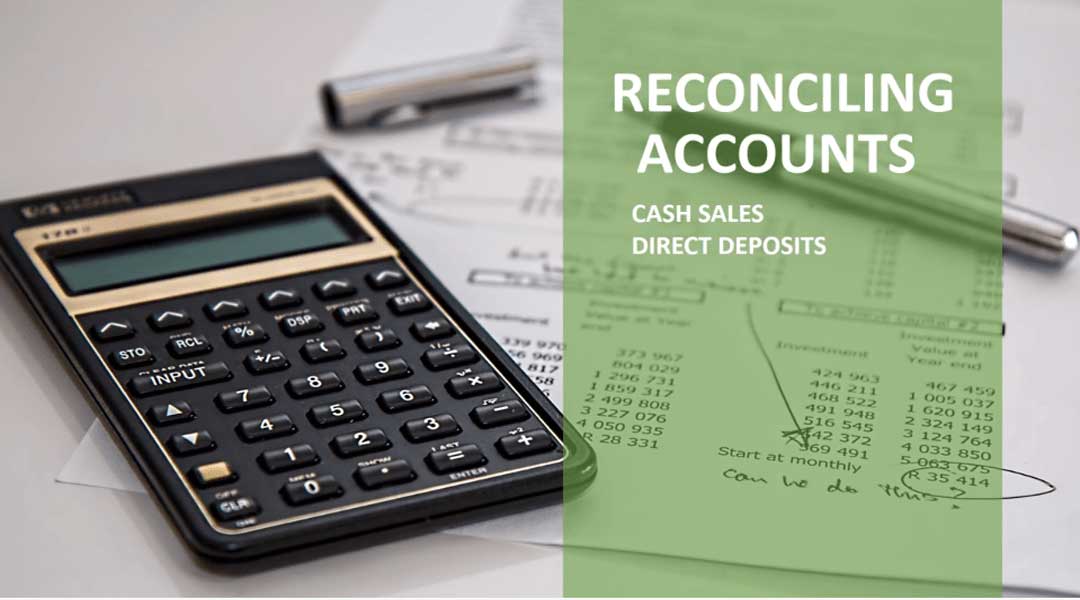
One of the most overlooked steps in the accounting process is completing a bank reconciliation. We’ll take you step-by-step through the process of completing bank reconciliations for your business.
In this day of electronic banking, many people believe completing a bank reconciliation is no longer necessary. However, small business owners and bookkeepers need to remember that yes, banks do make mistakes, and one of the best ways to find those mistakes is by reconciling all of your bank accounts monthly.
Completing a bank reconciliation entails matching the balances on your bank statement with the corresponding entries in your accounting records. The process can help you correct errors, locate missing funds, and identify fraudulent activity.
Most accounting software applications indeed offer bank connectivity, which can speed up the reconciliation process immensely. However, connecting your accounting software to your bank or financial institute does not take the place of doing month-end bank reconciliation.
In this guide, we’ll explain exactly why doing a bank reconciliation is so important and give you step-by-step instructions on how to complete one.
Overview: What is bank reconciliation?
Bank reconciliation helps ensure that your ending bank statement and your general ledger account are in Balance.
Remember, your cash or bank accounts in your general ledger should reflect the same activity on your bank statement. If it doesn’t, you need to determine what’s missing. Figure out if it’s missing from the bank statement balance or the general ledger balance, and then reconcile the two numbers.
How to do a bank reconciliation
Most business owners receive a bank statement, either online or in the mail, at the end of the month. Most businesses set up accounts to run monthly, though some older versions may have a mid-month end date.
If that’s the case, you can still reconcile the statement; you’ll have to run a general ledger report ending on the same day as the bank statement. For instance, if your bank statement period is 1/11/2020 through 2/10/2020, you would run a general ledger or trial balance for that same period.
Fortunately, many accounting software applications include a bank reconciliation template or form in the application, which allows you to easily reconcile any of your bank accounts connected to your software.
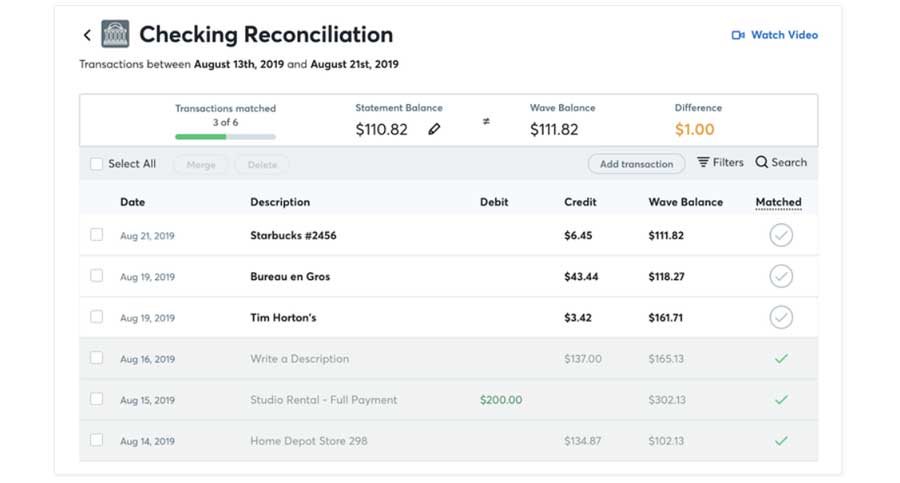
However, for those preferring to not connect their bank accounts to their software or for any business using software that doesn’t offer a connectivity option, here are the steps to follow to reconcile all of your bank accounts.
Step 1: Prepare your reconciliation form.
Your bank reconciliation form can be as straightforward or as detailed as you like. Below is an excellent example of a simple reconciliation form. For example, your bank statement shows that your ending balance is $11,450, while your G/L Balance, according to your trial balance, is $10,850.
The goal is to get your ending bank balance and ending G/L Balance to match.
Bank Reconciliation
For the period ending 1/31/2020
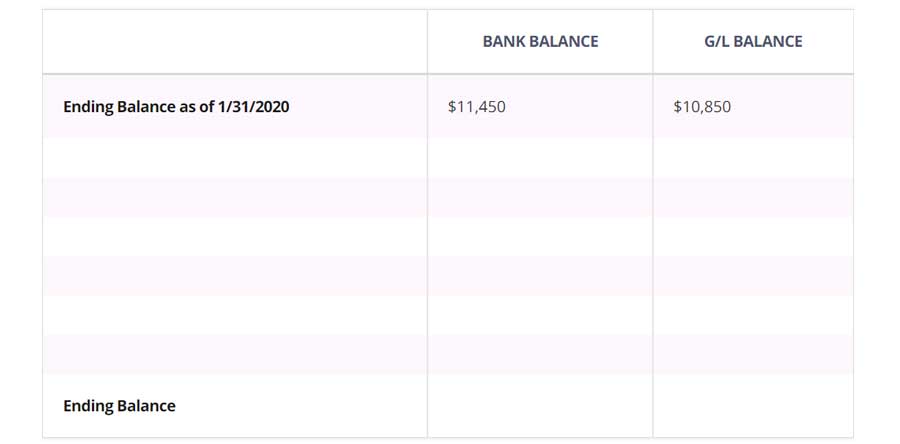
Tips for preparing your reconciliation form
While completing a bank reconciliation is not difficult, it does require that you pay attention to detail. Pay particularly close attention to the following:
- Double-check that your dates match: You’ll never be able to reconcile your accounts properly if your dates don’t match up. If your bank statement is dated 1/30/2020, you’ll want to run your trial balance as of 1/30/2020. If not, you’ll spend a lot of time on a reconciliation that you’ll likely never balance.
- Be sure to use the ending bank balance: If you’re new to reconciling bank statements, it’s easy to jot down the beginning balance rather than the ending Balance. Again, attention to detail will help.
Step 2: Compare deposits
If you commonly make deposits into your account, you’ll want to compare your bank account deposit totals to those listed in your general ledger. Remember, banks make mistakes, too, with transposition errors common. Be sure all of your bank deposits match.
Tips for verifying bank deposits
This is an important step. For instance, if you have a deposit for $850 that is in the G/L, but the bank leaves off the zero, recording the deposit as $85 instead?
That means your account could quickly become overdrawn, with penalties and fees adding up in a matter of days. This is probably the most critical step in the entire bank reconciliation process.
- Record your cash deposits in the G/L in the same amount as the deposit: While this may sound confusing, what it means is don’t post three deposits together in one lump sum in your G/L while keeping them separate when depositing. For instance, you have three different deposits on January 15 for $250, $600, and $99.50. Instead of recording them as $949.50, record them separately, the same way you deposited them.
- Please don’t assume the bank is always right: We trust our money with banks every day, and for the most part, there are no problems. However, it only takes a few minutes to check the accuracy of your deposits. Assume nothing.
Step 3: Compare checks and adjust the bank total.
It’s common for your bank statement to have a higher ending balance than your G/L account shows. While it may be tempting to assume you have more money in the bank than you think, it’s a safe bet that the difference is checks and other payments made that have not yet hit the bank.
The easiest way to check for this is to print a check register for the month and compare it to the checks that have cleared the bank. Any checks that have been issued that haven’t cleared the bank must be accounted for under your bank balance column.
For instance, you paid two vendors by check on January 31. Those payments are recorded in your G/L, but they have yet to hit the bank. It would help if you subtracted both checks from your bank balance, as well as any other checks listed in your check register that haven’t cleared.
Bank Reconciliation
For the period ending 1/31/2020
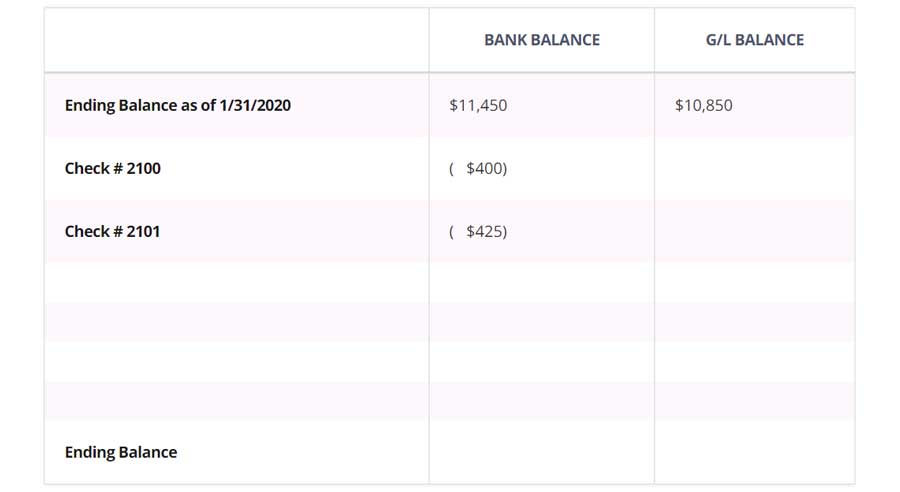
Tips for finding outstanding checks
When you’re completing a bank reconciliation, the most significant difference between the bank balance and the G/L Balance is outstanding checks.
- Print a check register and compare it to the checks that have cleared: The easiest way to check for outstanding checks is to print a check register and compare it to checks. If this step isn’t completed, the bank balance will be overstated.
- Check ACH transfers as well: Not all ACH payments happen immediately. If you pay vendors by ACH transfer, consider that a payment made late in the month will not clear the bank until the following month. Be sure to check all outgoing payments, no matter what form they may take.
- Be sure to include outstanding checks from previous months: Remember to check each month to ensure that any outstanding checks from the last month have cleared the bank. If they haven’t, you will have to continue to put them on the bank reconciliation form until they clear or until you cancel the check to reissue a new one.
Step 4: Find G/L adjustments.
Notice that the bank reconciliation form above still does not balance, even after including the outstanding checks. This means the bank has made an adjustment to your account that has not been recorded in your G/L.
These items are typically service fees, overdraft fees, and interest income. You’ll need to account for these fees in your G/L to complete the reconciliation process.
Tips for finding G/L adjustments
The easiest way to find these adjustments when completing a bank reconciliation is to look at the bank fees. You’ll also want to look at any miscellaneous deposits that haven’t been accounted for. Once you locate these items, you’ll need to adjust your G/L Balance to reflect them.
For instance, the bank charged your business $30 in service fees, but it also paid you $5 in interest. Below is an example of a completed bank reconciliation statement.
Bank Reconciliation
For the period ending 1/31/2020
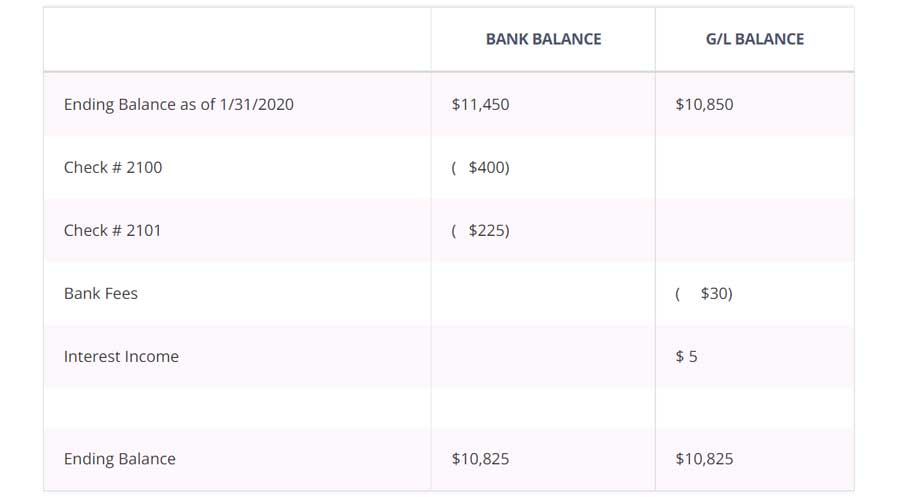
- Check the bank for any service fees: Service fees will not be included in your G/L Balance since they weren’t charged to your account until the end of the bank statement period. These will need to be adjusted in your G/L.
- Check for any unaccounted for deposits as well: Your bank may pay you monthly interest, or someone may have transferred money to your account that has not been accounted for in your G/L. Any deposits in transit that are not already posted to your G/L will need to be added, and a journal entry created for your reconciliation to balance.
Step 5: Create journal entries
The final step in the bank reconciliation process is to record journal entries to complete the balancing process.
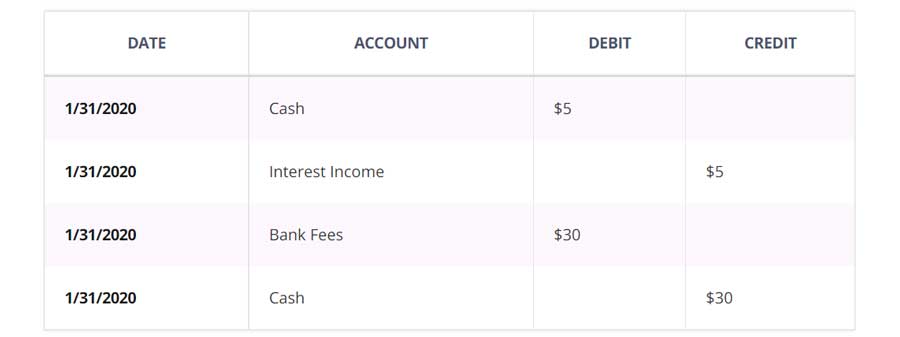
You will be increasing your cash account by $5 to account for the interest income, while you’ll be reducing your cash account by $30 to account for the bank service fee.
Tips for creating journal entries
Remember that outstanding checks do not need to be recorded into the G/L since they are already there. However, anything that affects the G/L, such as unexpected deposits, interest income, or service fees, will need to be recorded.
- Look for items not already accounted for: Since part of the bank reconciliation process includes matching checks and deposits, you’ll want to look for anything that does not fit into these categories, as well as items such as a check that clears that does not belong to your business or a deposit you did not make.
- Don’t forget to complete the necessary journal entries: While it’s exciting to get your bank reconciliation form to Balance, it’s easy to overlook bank reconciliation journal entries. Be sure you see the process through and that your new G/L report reflects the new entries before closing entries are completed.
Frequently Asked Questions for Bank Reconciliation
Do I need to reconcile all of my bank accounts?
Any active accounts should be reconciled at month-end, even if there are only a few transactions.
What if I can’t reconcile the two balances?
If you’ve entered adjustments for both your bank balance and your GL balance, and there is still a bank reconciliation problem, you will need to continue to review both your bank statement and your G/L to locate the missing item.
This may require going back several months to find the issue, which is why reconciling each month is so important.
How do I get started?
If you’re doing a bank reconciliation for the first time, it can be helpful to look at a bank reconciliation example to ensure that you’re doing it correctly.
Bank reconciliations are a must.
Among the various accounting terms and processes you need to understand, such as preparing a budget or tracking business expenses, perhaps one of the most important is completing the bank reconciliation process for all of your active bank accounts.
Designed to keep your bank and your G/L in Balance, the bank reconciliation process also helps you correct possible errors, account for uncashed checks, and even locate missing deposits. Don’t underestimate the importance of this vital tool.
If you’re interested in automating the bank reconciliation process, be sure to check out some accounting software options.
Source: fool.com
Newsletters
Newsletter December 2021
NewslettersEvents & SponsorshipArticles & Publications
Newsletter – June 2021
NewslettersEvents & SponsorshipArticles & Publications
Newsletter – May 2021
NewslettersEvents & SponsorshipArticles & Publications
Newsletter – April 2021
NewslettersEvents & SponsorshipArticles & Publications
Newsletter – March 2021
NewslettersEvents & SponsorshipArticles & Publications
Events & Sponsorship
Toronto Entrepreneurs Conference @ Mississauga
May 08, 2019 Our B.E.S.T. (Business Entrepreneurs Services Team) Group has participated in this event for first time. Toronto Entrepreneurs Conference and Trade Show is the largest Entrepreneurs event in Canada. The event which targets business owners, partners or...
Hispanic Fiesta 2018
September 04, 2018 RGB Accounting will participate in this event for a second year in a row. Hispanic Fiesta will be held at Mel Lastman Square in Toronto during the Labour Day Weekend, August 31st, Sept. 1, 2, & 3, 2018. Hispanic Fiesta is a four-day celebration...
Secure Your Future Seminar 2018
June 20, 2018 This event gathered business owners running a small or medium-sized business, self-employed and incorporated businesses willing to learn tax saving strategies to help them utilize their company assets to secure their retirement. We are proud of having...
2nd Latino Business Expo Show
May 19, 2018 The 2nd Latino Business Expo Show held on May 19th at Daniels Spectrum gathered a wide range of entrepreneurs and business owners avid to learn how to take their businesses to the next level. RGB Accounting participated as vendor and speaker at this...
Hispanic Fiesta 2017
September 04, 2017 Hispanic Fiesta, a celebration of Spanish and Latin-American: Arts, Food, Music and Entertainment, is a four-day celebration filled with the splendid sounds, tempting treats and colorful culture featuring 300 local, national and International...
Articles & Publications
The Surprising Medical Expenses You Can Claim with the CRA!
The Surprising Medical Expenses You Can Claim with the CRA! In the realm of medical expenses, which are often deemed both essential and financially burdensome, the Canada Revenue Agency (CRA) emerges as a potential source of relief for Canadians. While the CRA...
Shareholder Owners Salaries vs Dividends
NewslettersEvents & SponsorshipArticles & Publications
Understanding the Shareholder Loan
Understanding the Shareholder Loan. How to Use it to your Advantage and Stay Compliant with CRA If you are the owner-manager of a corporation, understanding the concept of the shareholder loan is essential to running your business. Below I will explain what a...
GST/HST for digital economy businesses
GST/HST for digital economy businesses Overview New rules for digital economy businesses are in effect as of July 1, 2021. As of July 1, 2021, digital economy businesses, including digital platform operators, may have potential goods and services tax/harmonized sales...
Ten things to know before filing your tax return this year
Ten things to know before filing your tax return this year Here are ten things to keep in mind as you work your way through this tax season. The deadline The regular tax-filing deadline for most individuals is usually April 30, but you have until May 2 this year to...